
Switzerland - Travys
For a full scale picture, please click on the picture shown !
Travys - Yverdon - Ste Croix railway
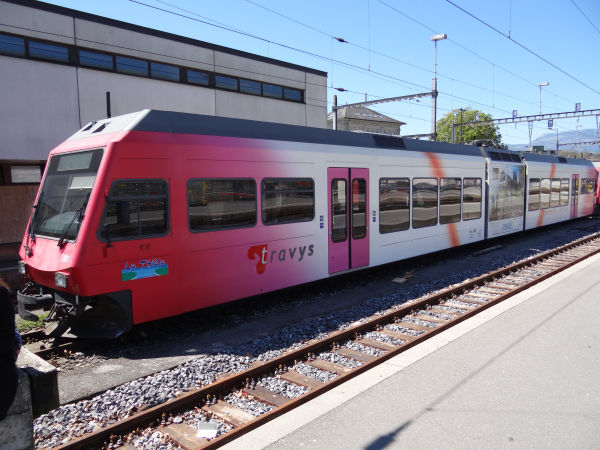
Travys is the brand name of a public transport company operating several rail and bus lines in the Yverdon region in the north of the
Swiss canton of Vaud. Earlier the main parts of what today is Travys, were the two small railroads Chemin de Fer Yverdon - Ste Croix
and the Vallée du Joux railway. Yverdon - Ste Croix is narrow gauge, but Vallée du Joux railway is normal gauge.
The small normal gauge railway OC, Orbe - Chavornay now also belongs to Travys, but on this website OC is shown on a separate page.
This Stadler-made electric multiple unit of the type GTW 2/6 is officially at Travys classed as Be 2/6 no.2001.
It was ordered and delivered already before the railroads fusioned into Travys. But here we see it now in Travys'
new livery.
Picture from Yverdon-les-Bains 5.5.2016 by Ilkka Siissalo.

This GTW 2/6 no.2000 did not yet in 2016 have the stickers of Travys on its sides. The texts were still talking about Yverdon - Ste Croix
railway.
Picture from Yverdon-les-Bains 5.5.2016 by Ilkka Siissalo.

Travys' very newest motorwagon, Be 4/4 no.3006 is also built by Stadler.
Picture from Yverdon-les-Bains 5.5.2016 by Ilkka Siissalo.
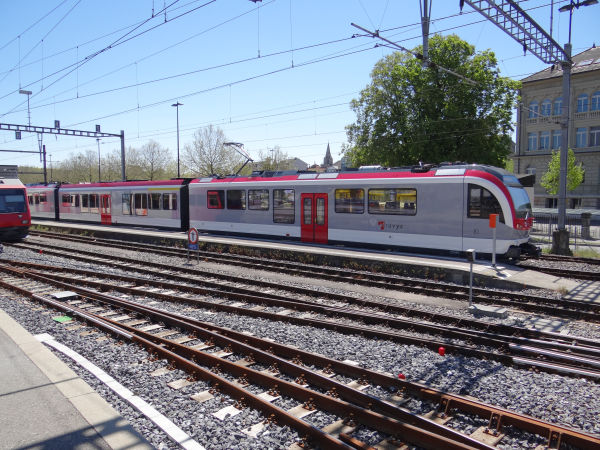
Side view of the new motorwagon Be 4/4 no.3006.
Picture from Yverdon-les-Bains 5.5.2016 by Ilkka Siissalo.
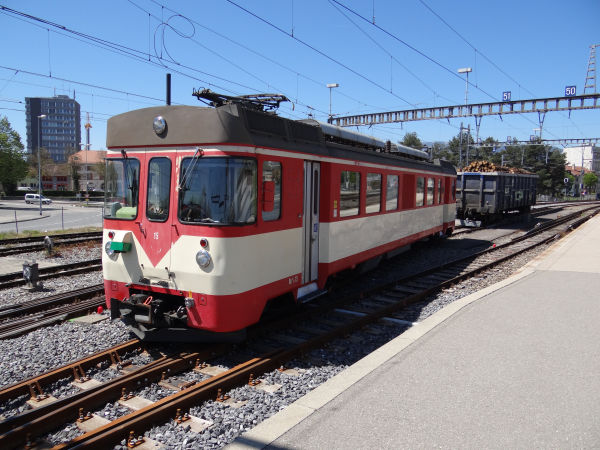
In 2016 Travys was using this old motorwagon Be 4/4 no.15 as a locomotive. Here it is just pulling a normal gauge loaded cargo wagon on top of
another pair of bogies which convert it to narrow gauge.
Picture from Yverdon-les-Bains 5.5.2016 by Ilkka Siissalo.
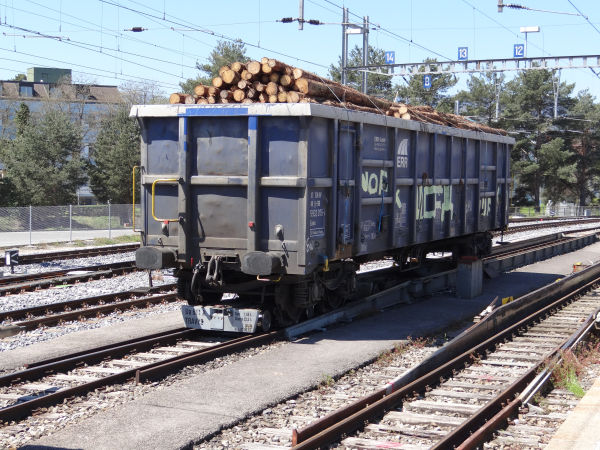
With these ramps a normal gauge wagon can be simply rolled on top of a second set of bogies, in German called as Rollschemels which convert
the wagon to narrow gauge.
Picture from Yverdon-les-Bains 5.5.2016 by Ilkka Siissalo.

Travys' motorwagon Be 4/4 which has been renumbered to now being no.1. has been built in 1981 and it carries the name "Yverdon". It can still be used
in passenger traffic as well as acting like a locomotive to move normal gauge wagons put on "Rollschemel" bogies as shown above. Lately it seems it
has again been in passenger traffic together with an unmotorised steering cab coach Bt55 which is similar with the coaches of the newer GTW 2/6 trains.
No.15 shown above was similar and from the same year than the current no.1, but no.15 is no longer active, and has been sold. Currently this no.1 is
the only one of the older Be 4/4 motorwagons.
Picture from Yverdon les Bains 12.5.2023 by Ilkka Siissalo.

Another view of the Be 4/4 no.1. It's now the only remaining motorwagon from the series built in 1981.
Picture from Yverdon les Bains 12.5.2023 by Ilkka Siissalo.
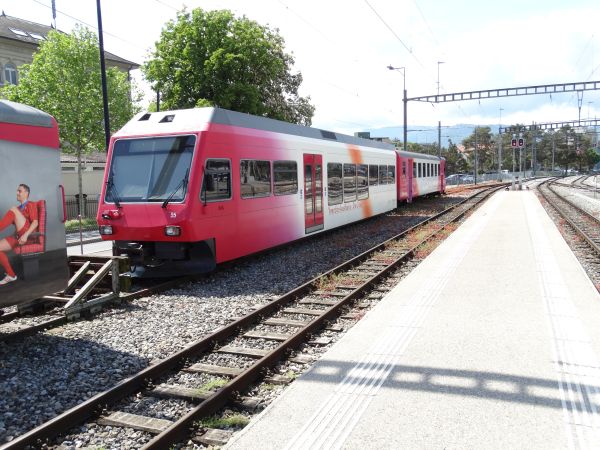
A peculiar composition. The newer wagon seen in front of us looks like as if it was from a GTW 2/6 train. But GTW trains' coaches have just one bogie.
The idea is to have a small power pack module in the middle of the train. This one differs in that it has some kind of a bogie even at the end of the coach.
When these two steering cab coaches are attached to the old motorwagon no.1 shown above, the combination can work and it is also legal since it has at least
a part of one of the coaches low-floor and therefore legally speaking is officially accessible. Neither one of these steering wagons has an engine, but
combined with the motorwagon shown above it can operate.
Picture from Yverdon les Bains 12.5.2023 by Ilkka Siissalo.
The former Yverdon - Ste Croix railway
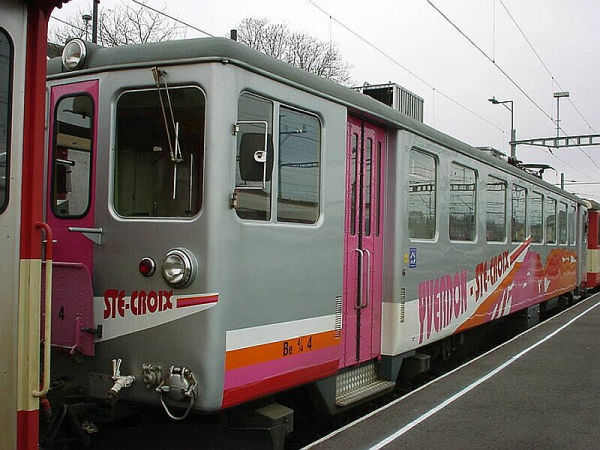
YSteC - Chemin de Fer Yverdon - Ste-Croix was a small private railroad in the French speaking part of Switzerland, between the towns of Yverdon-les-Bains and
Ste-Croix. Yverdon lies at the SBB main line between Zürich and Geneve and Ste-Croix is a small town close by, high up on the Jura
mountain hillsides, so this was once again a classic case of Swiss style feeder traffic to the "real" railway. The line is only 24 km long. It is a
narrow gauge railroad with 1 m gauge width, but it is using the electricity system of "normal trains", 15 kV 16,7 Hz AC. The
line was opened for traffic in 1893. Still in the 1990s YSteC had one locomotive, only the classic "narrow gauge Crocodile" shown below, two EMU wagons from
1945 and three EMUs from 1981 as well as then by the turn of the century some newer multiple units before it was fusioned into what today is Travys.
The small company YSteC or Chemin de Fer Yverdon-Ste-Croix had only five electric motor wagons - this is the oldest of which, but
in new livery. The Be 4/4 I series EMU no. 4 was built already in 1945. There were two of these motor wagons at YSteC. It was 18,79 m
long, weighed 39 tons and had a maximum speed of 65 km/h. YSteC bought these EMUs after electrification of the network in the 1940s.
Two smaller, similar Be 2/4 EMUs were already scrapped, but these two, numbers 4 and 5 were still in use, typically with more
modern steering wagons like in this picture. The old EMU was "surrounded" by two modern steering wagons.
Picture from Yverdon 1.11.2001 by Ilkka Siissalo.
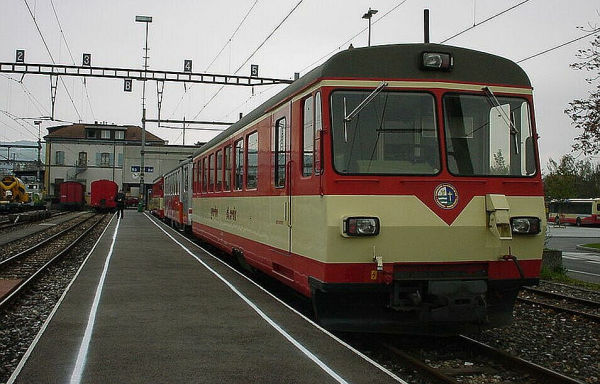
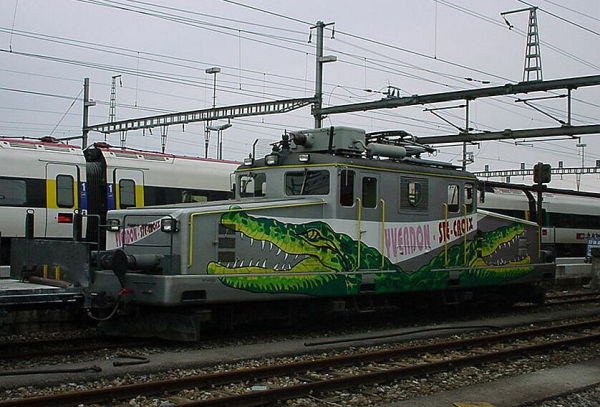
The "Yverdon Krokodil", Ge 4/4 no 21 is built in the same style as the original "Crocodile" locomotives of the 1920s, but this
narrow gauge small croc originates from 1950 and actually uses far more modern technology than its predecessors. It is the only
real locomotive of what used to be YSteC. The Yverdon Krokodil is only 12,88 m long, but still weighs 41 tons.
Its maximum speed is a modest 55 km/h, but in practise even that is a lot on the curvy tracks along the hillsides. Still in 1996 this
locomotive had a fairly stylish 1950s creme and wine red finish, but afterwards YSteC had it repainted and covered with stickers to look "modern".
I doubt whether the newer paintings were an improvement?
In the background a brand new SBB "bullet train" of the ICN type.
Photo from Yverdon station at 1.11.2001 by Ilkka Siissalo,
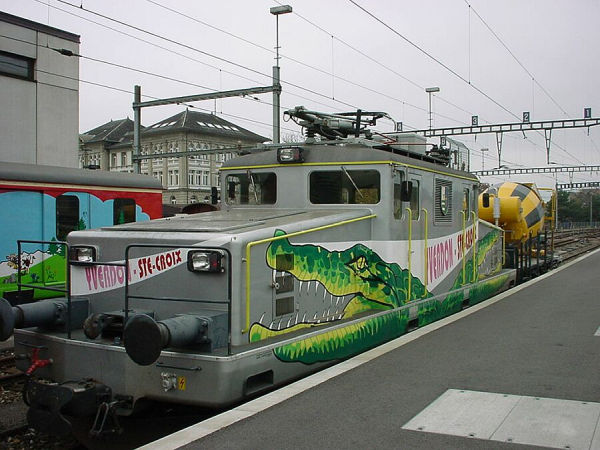
Another view of the "Yverdon Krokodil" locomotive from 1950. The engine was modernised and looks now completely
different from how it had been shown in books (if you have a chance, see for example the excellent small book: K. Hartung: Kleine
Typenkunde Schweizer Triebfahrzeuge, Transpress, Germany 1997). Its lamps were small and round and it definitely did not have a
modern Einholm pantograph. Painting was wine red, with a stripe of cream on the sides: it looked older, yet more "serious" and
somehow bigger. To say the least, more "serious".
Despite its wery short "network" of just 24 km of railroad line, YSteC actually had quite some cargo traffic, believe it or not. When the route was
electrified in 1945 it soon turned out that in the post-war situation with not enough cars, the Be 4/4 EMUs could not take enough
cargo, so this cargo locomotive was really needed in 1950. As shown in a separate picture, the YSteC manageed to take normal SBB cargo wagons
on its narrow gauge rails by means of these extra bogies (in German: Rollschemeln) and this locomotive. This explains the relatively
active cargo traffic of for example timber trains on the YSteC line.
Photo from Yverdon station at 1.11.2001 by Ilkka Siissalo.

This (and also the picture of the YSteC "Yverdon Krokodil" locomotive) show how YSteC had been playing with colourings, not quite to
the liking of everybody: The original 1980s style colouring had been totally spoilt by the childish graffiti-like taping. Is this
good marketing ? This wagon is a small baggage department wagon, which is intended to be added to trains as needed to accommodate
bicycles and other bigger baggage items.
Photo at Yverdon station from 1.11.2001 by Ilkka Siissalo.
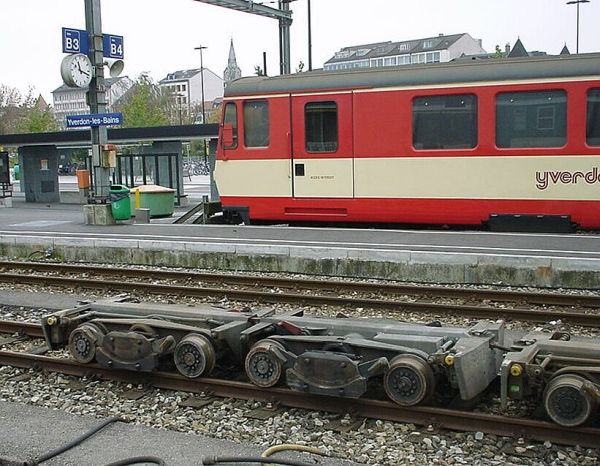
YSteC managed to take "normal" SBB cargo wagons uphill along its narrow gauge route by putting these small "adapter bogies" (German: Rollschemel) under the axles
of the normal gauge wagons. They do the trick of fitting the wagons to only 1 meter gauge width.
Photo from Yverdon station at 1.11.2001 by Ilkka Siissalo
Vallée du Joux railway, Vallorbe - Le Brassus
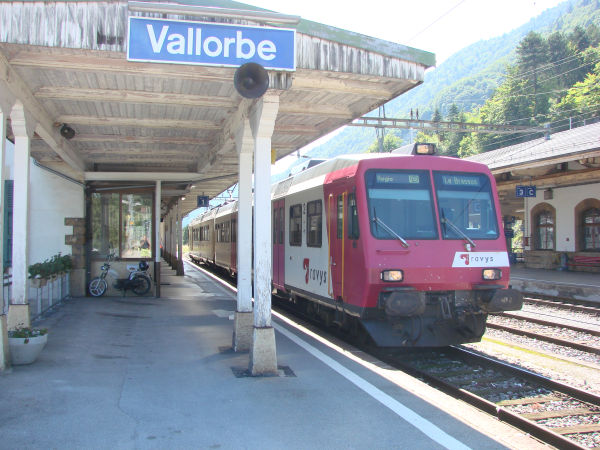
The Vallée du Joux railway from Vallorbe to Le Brassus was always a private railroad, but for tens of years the federal railroads SBB operated it
using old SBB trains in SBB paintings. That all changed when the railroad became a part of Travys. This train in itself has nothing new in it,
it's an old SBB "Neue Pendelzug" (new pendeling train), originally classed as SBB RBDe 560, now classed as Travys RBDe 568 and now painted in Travys'
own colours.
Picture from Vallorbe 13.7.2007 by Ilkka Siissalo.
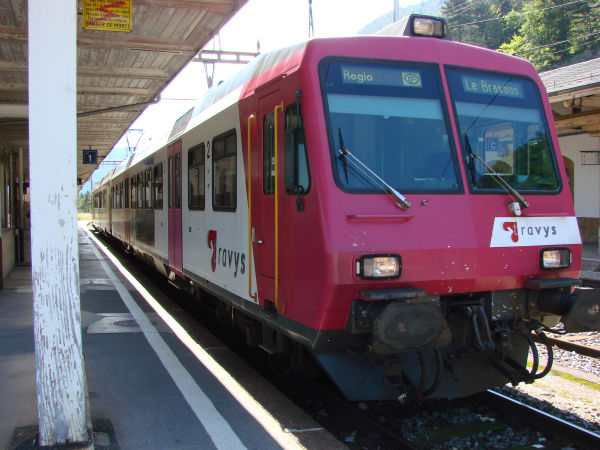
Another view of the Vallée du Joux railway RBDe 568 "Neue Pendelzug".
Picture from Vallorbe 13.7.2007 by Ilkka Siissalo.
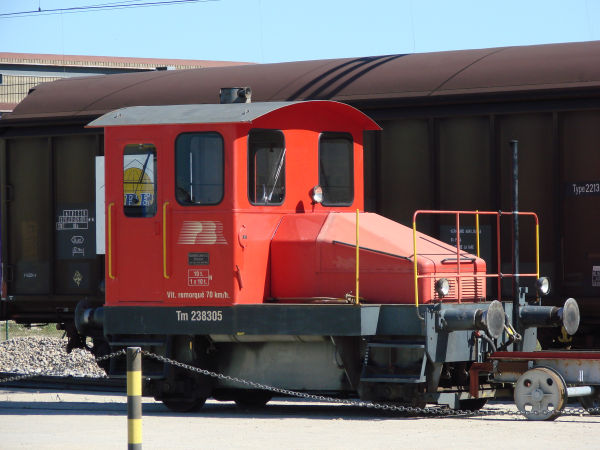
Before its fusion as part of what is now Travys, the Vallée du Joux railraod was often referred to as PBR, Chemin de fer Pont–Brassus.
This small diesel locomotive, or rather, officially a rail tractor of the type Tm 238, was owned by PBR. Here it was used for shunting
at the Nestlé instant coffee factories in Orbe.
Picture from Orbe 13.7.2007 by Ilkka Siissalo.

